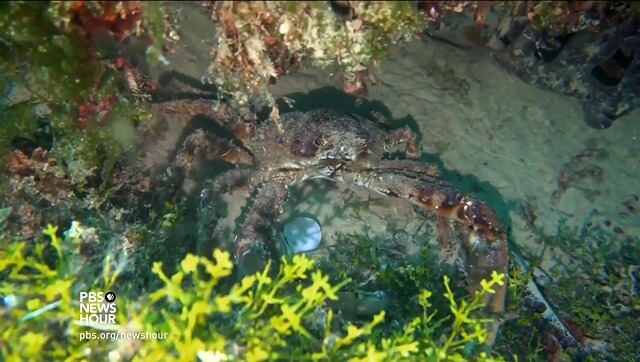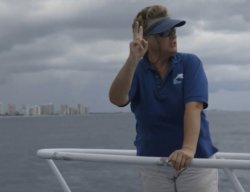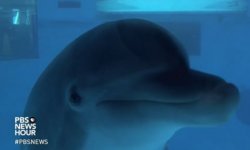While the Whale Sanctuary Project pursues its plan to create the first seaside sanctuary for captive orcas and belugas, the National Aquarium is working to create a sanctuary for all its dolphins.
And this week, the PBS Newshour accompanied John Racanelli, the Aquarium’s CEO, as he checked out some possible sanctuary locations in Florida.
“We need to get out of that awful era that we have been through for the last 100 years of caging animals,” Racanelli tells PBS Science Correspondent Miles O’Brien as they drive along the Florida Keys to a long-abandoned limestone quarry that’s naturally filled with water, plant and animal life of all kinds from the Gulf of Mexico.

Checking out a location for a dolphin sanctuary, John Racanelli of the National Aquarium finds life everywhere.
After donning a wetsuit to explore the seaside quarry as a possible sanctuary, Racanelli compares the natural environment to what the dolphins experience in a concrete tank.
“The thing that was most impressive was, there was life everywhere. Everywhere! Every time you turn around, a bunch of little clams and scallops were closing their doors. Did you hear the snapping shrimp?”
If all goes according to plan, the dolphins will move to their new home in 2020. And while they’ll still be given human care, they’ll be living in a whole new world.
“It’s an exciting experiment,” Racanelli says, “because everything we’re doing is groundbreaking. And there is something about that that’s very satisfying, to give these dolphins the opportunity to truly thrive.”
“Attitudes Are Changing”
The Newshour first talked with Racanelli about moving the dolphins to a sanctuary back in 2016 when the Aquarium had just announced its plan. At that time, Racanelli told correspondent O’Brien:
“Baby boomers grew up on Flipper, and millennials grew up on Free Willy. So, attitudes are changing. And that is certainly a factor. It’s something we pay close attention to.”
O’Brien describes how we humans have been capturing and training dolphins for entertainment for about 80 years.
“Over time, the shows got more elaborate, even garish, the crowds larger, and the venues added the dolphins’ cetacean cousins, orcas, to the marquees.

Dolphins being “petted” at the Georgia Aquarium – the very opposite of a natural environment.
“… They are trained to do circus tricks, give thrill rides, and be docile with customers in glorified petting zoos, often called a dolphin experience.
“Looking at their permanent ‘smile’, it is easy to misconstrue what this experience is really like for them.”
Dolphin advocate Ric O’Barry tells O’Brien, “It’s really the dolphin ‘smile’ that has created this multibillion-dollar industry.”
O’Barry, who trained dolphins for the TV show Flipper, gave up his career to advocate on behalf of the dolphins. Their apparent smile, he says, is “literally an optical illusion.” It may look cute to human eyes, but it’s just the shape of their face. And it’s brought them the very opposite of good fortune.

Marine mammologist Denise Herzing preparing to dive with spotted dolphins.
O’Brien also talks with scientist Denise Herzing, founder of the Wild Dolphin Project, who has been studying spotted dolphins in the Caribbean for more than 30 years.
“They’re very smart. They problem-solve. They can think in the abstract and recognize that. They have very good comprehension and cognitive skills, so they can understand artificial languages that are presented to them.”
Herzing tells O’Brien it’s time to create dolphin retirement centers.
“We’ve done it for other species. We’ve done it for chimps, elephants, giraffes,” she says. “You name it, we’ve done it. Dolphins are hard. It’s a different environment. It’s expensive. But we owe it to them.”
O’Brien asks her whether future generations will be missing out on a teachable moment when the dolphins have left the Aquarium.

Skype from a sanctuary? A better way for young people to learn about dolphins!
“[But] what are you really teaching your kids [at an aquarium]?” she replies. “Are you teaching your kids it’s OK to confine an animal, to capture an animal for human viewing?”
Racanelli adds: “I think we will be able to ensure that people still get a chance to tune into the lives of these dolphins in a way that inspires them, yet not have to have them here in Baltimore. Maybe dolphin Skype is in our future!”
To which O’Brien concludes: “And maybe then, when people dial up the dolphins for a virtual visit in their more natural habitat, their smile will be more than an illusion.”
2 Comments
As a #DolphinProject advocate #RaisingAwareness via social media to the plight of Dolphins in captivity & the senseless slaughters in #TheCove #Taiji #Japan each year, I am so excited about this sanctuary! Who knows, within time all cetaceans currently in captivity may even be released into the wild to be free as they should be!
#DoTheRightThing #DontBuyATicket #SayNo2Captivity #CaptivityKills #EndTheDemand #StopTheSupply #ThanksButNoTanks #EmptyTheTanks #SaveDolphins
This is a fine story. There is another PBS film which says “a leading contender” for the dolphin sanctuary is a limestone quarry.
Oh No….
The sanctuary idea will lose credibility if dolphins move from a concrete tank to a limestone tank.
https://www.pbs.org/newshour/show/dolphins-raised-in-captivity-will-soon-get-a-new-more-natural-home
A limestone tank is scarcely better than the concrete tank they have now. It is not naturalistic. Acoustic animals need soft mud or vegetated surfaces to attenuate rather than echo their sounds.